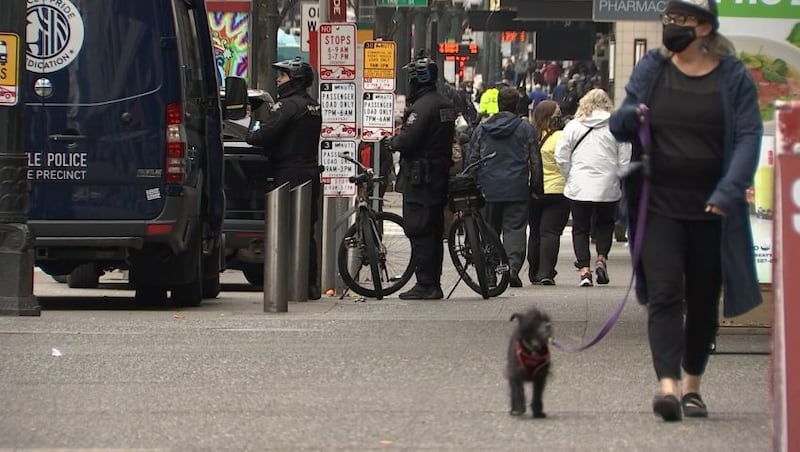SEATTLE — Long-term improvements are coming to downtown Seattle. Some of those plans target the 3rd Ave and Pine St neighborhood – which still has a big police presence two weeks after a string of violent crimes.
There is also a big construction project finally in the works in a space that’s been empty for more than 15 years.
People downtown are hopeful that these are signs of meaningful change.
“Definitely a difference of night and day since the precinct showed up and the huge police presence,” said Leslie Buker, who lives in the 3rd and Pine neighborhood. Businesses and residents say the area feels much safer since police arrived.
“I can go jogging in the morning, and I’m not worried about who is camped outside my front door,” Buker said. “I’m not looking over my shoulder as much.”
The city doesn’t have a time frame for how long the major presence of Seattle police will be in the corridor, but Mayor Bruce Harrell has said they are working on long-term plans to change the neighborhood, including exploring solutions like more lighting and changing up certain bus stops.
The mayor’s office said it’s currently working on changing the “norms” for the area of 3rd and Pike by having officers conduct informal outreach about what’s considered “disorderly conduct” in and around transit stops. Essentially, the code prohibits people from drinking, smoking, littering, or doing anything disruptive that’s not transit-related within 25 feet of a bus stop or transit station.
A spokesperson said on Thursday the timing and method of the enforcement piece of the plan were still being evaluated.
Jon Scholes, president and CEO of the Downtown Seattle Association says while there has been improvement, there is also more work to do.
“We’ve made some progress in recent weeks. I think we’re headed in the right direction, we’re on the right track. But we can take anything for granted. I think we are at a fragile point,” Scholes said.
Scroll down to continue reading
More news from KIRO 7
- Pierce County deputy Dominique “Dom” Calata dead after Tuesday’s shooting
- Two deputies shot in Spanaway, one in grave condition; suspect dead
- St. Patrick’s Day 2022: How did it get started; why corned beef and cabbage; who is Patrick?
- Do you have an investigative story tip? Send us an email at investigate@kiro7.com
He believes one way to transition 3rd Ave from a temporary fix with the mobile police precinct to something more permanent is to revisit a “Third Avenue Vision” beautification plan developed just before the pandemic hit. He says now that plan is getting renewed interest. Possibilities include bringing in more trees, developing a transit median to open up sidewalks, and having more outdoor café seating.
“We need to invest in that transit core, so it’s lighter, brighter, better place and more delightful place to get on and off the bus,” Scholes said.
Another sign for a changing downtown -- developers for the long-vacant lot across from city hall say they’re ready to start construction in April. Bosa Development said in a news release that the 3rd and Cherry city block will become a 57-story building with 422 condos, retail space on the ground floor, and a public plaza.
The lot has sat empty for about 17 years since the old public safety building was demolished in 2005. Now there is vegetation and even several trees growing in the pit.
“The downtown core needs people, so I’m happy they’re building something there, especially in this particular location. I think it’s great for the city of Seattle,” said Bill Flud, who works in downtown Seattle.
“We’re thrilled to start construction on our new project and bring life to this long-vacant city block,” said Ryan Bosa, president of Bosa Development, in the press release. “It is destined to become the most transformative new development in downtown Seattle, enriching the urban fabric within the core of the city.”
But Flud says that while he’s optimistic about the future, it doesn’t feel like Seattle has turned the corner yet.
“What’s sad for me is my staff that walk to public transit feel unsafe, and they don’t want to work downtown,” Flud said. “I’m hopeful that as people come back downtown after the pandemic that we’re going to find that it feels like a real city again and not a wasteland.”
In the DSA’s annual State of Downtown on Thursday, the organization said more people than ever before live downtown – nearly 100,000 people. Nearly 170 new street-level businesses opened downtown in the past 12 months, including nearly 70 restaurants and 30 new retail shops. However, downtown office foot traffic is still only 30% of pre-pandemic levels.
©2022 Cox Media Group








